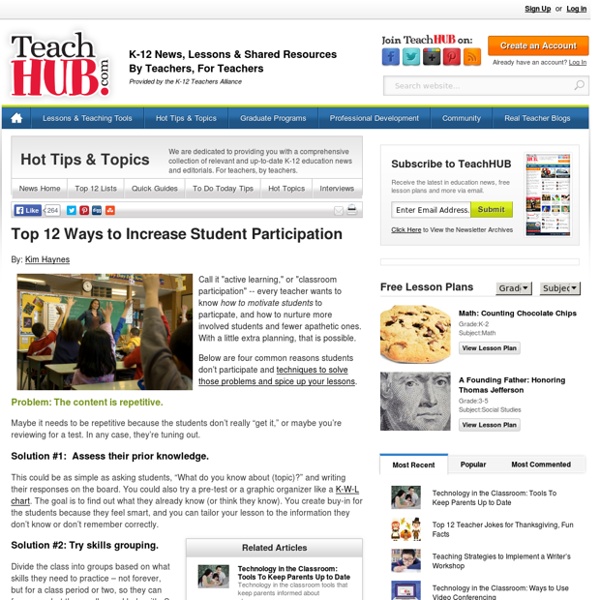Top 12 Ways to Increase Student Participation

I Love That Teaching Idea!
How to Crochet: Star Stitch
By Erin Burger – 96 Comments Out there in Crochet Land there are many ‘special’ stitches that I call ‘YO Stitches’ (the abbreviation for yarn over is yo). These stitches include the popcorn stitch, the bobble stitch, the puff stitch etc…etc… My favorite of these type of stitches is the star stitch. This tutorial is for both right and left handed people. Start by chaining a multiple of 3, then add 1 more chain. Row 1: pull up a loop in 2nd ch from hook and in each of the next 4 ch, yo and pull through all 6 stitches on hook (where will be a total of 6 loops, disregard error in this first photo which only shows 5), ch 1 to close star. This is your first star and it should look like this (continue on with pattern) * Pull up a loop in ch-1, pull up a loop in last ch of star just made, pull up a loop in each of the next 3 ch, yarn over and pull through all 6 loops on hook, ch 1 to close star, repeat from * across, hdc in last ch. Row 2: ch 2, turn, 3 hdc in each ch-1 from the previous row, ch3 turn.
DROPS Pattern Library: Lace patterns
DROPS pattern library contains patterns, and it keeps growing every day! The DROPS designers want you to see how these different techniques will look when applied to a knitting or crochet project. This is a very useful tool when you are looking for inspiration for own designs. Remember that by switching between yarn quality thicknesses and by picking a different knitting tension you will be able to create a new aspect to the design. Have fun! NOTE: Click on the flag/link under the picture to go to the full pattern. Back to the School of Handcraft Sort by: Yarn quality | DROPS number | Pattern type
How to Make Simple Crochet Slippers « Crafts
IMPORTANT NOTE: This pattern uses US crochet terminology. You can find the SLIPPER SIZE, YARN and HOOK specifications at the end of this article !!! (To see more of my patterns, please visit my ONLINE SHOP!) I am an addict. An addict for crochet slippers. It all began when I saw slippers similar to these somewhere on the internet. I loved them so much I couldn’t get their tempting image out of my head. All I needed was a pattern. But because I am terribly, terribly impatient, I found creating my own pattern quicker than looking for an official one on the web. And since I’m no crochet guru, the pattern turned out to be really simple. Actually, these slippers might be the simplest slippers in the universe. Or not. But they might. This is what I did… Round 1: 5 ch (chain stitch); join into ring with sl st (slip stitch) Round 2: 3 ch; 7 dc (double crochet stitch) into the center of the ring; join with sl st Round 3: 3 ch; 1 dc into first stitch; 2 dc into each next stitch; join with sl st Row 14: turn (!)
100+ Google Tricks for Teachers
It's Google's world, we're just teaching in it. Now, we can use it a little more easily. With classes, homework, and projects–not to mention your social life–time is truly at a premium for all teachers, so why not take advantage of the wide world that Google has to offer? From super-effective search tricks to Google tools specifically for education to tricks and tips for using Gmail, Google Docs, and Google Calendar, these tricks will surely save you some precious time. Search Tricks These search tricks can save you time when researching online for your next project or just to find out what time it is across the world, so start using these right away. Convert units. Google Specifically for Education From Google Scholar that returns only results from scholarly literature to learning more about computer science, these Google items will help you at school. Google Scholar. Google Docs 22. 23. 24. 25. 26. 27. 28. 29. 30. 31. Gmail 32. 33. 34. 35. 36. 37. 38. 39. 40. 41. 42. 43. Google Calendar 44.
Related:
Related:



